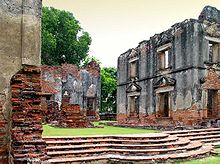- Maria Guyomar de Pinha
-
Maria Guyomar de Pinha, also Maria Guiomar de Pina, Dona Maria del Pifia, Marie Guimar or Madame Constance in French or Thao Thong Kip Ma (Thai: ท้าวทองกีบม้า) (Born in Ayutthaya in 1664), was a Siamese woman of the 17th century who lived in Ayutthaya, Siam (modern Thailand). She was the wife of the Greek adventurer Constantine Phaulkon.[1]
Maria Guyomar was a Catholic woman of mixed Japanese-Portuguese-Bengali ancestry.[2] Her mother was a Japanese, named Ursula Yamada, whose family had emigrated to Thailand following the repression of Christianity in Japan.[3] Her father Fanik Guyomar (also Phanik Guimar), from the Portuguese colony of Goa, was a Christian of mixed Japanese and Bengali descent.[3]
 The residence of Constantine Phaulkon and Maria Guyomar de Pinha (Baan Vichayen), in Lopburi, Thailand.
The residence of Constantine Phaulkon and Maria Guyomar de Pinha (Baan Vichayen), in Lopburi, Thailand.
In 1682, Maria married Phaulkon, soon after he abandoned Anglicanism for Catholicism.[4] They lived a life of affluence as Phaulkon rose to become highly influential at the Siamese court of king Narai.
During the period of rapprochement between France and the Siamese court Maria Guyomar de Pinha, together with her husband Phaulkon, was promised French protection by being ennobled a countess of France. During the 1688 Siamese revolution, after the assassination of her husband, Maria took refuge with the French troops in Bangkok, but the Commander of the French fort General Desfarges returned her to the Siamese under pressure from the new ruler Petracha on October 18.[5] Despite the promises that had been made regarding her safety, she was condemned to perpetual slavery in the kitchens of Petracha.[6] Maria remained prisoner until the death of Petracha in 1703, but became the head of the royal kitchen staff.[7]
One of her sons, George became a minor official at the Siamese court. Her second son, Constantin, is known to have been put in charge by king Borommakot (1733–1758) of building a German organ for the king.[8] According to French missionary sources he was called Racha Mantri and was at the same time a supervisor of the Christians in Ayutthaya and the official in charge of the royal storehouses.[9]
In her later life, Maria, together with her daughter-in-law Louisa Passagna (widow of Constantin), continued to sue the French East India Company to recoup money which her husband Phaulkon had lent to the company. She was vindicated in 1717 through a decree from the Council of State in France, which provided her with a maintenance allowance.[8]
Maria Guyomar is famous for introducing new dessert recipes in Thai food at the Ayutthaya court, based on Portuguese culinary influence, especially egg yolk-based sweets such as foi thong ("golden threads")[10] and sangkhaya.
Notes
- ^ Keat Gin Ooi, Southeast Asia: A Historical Encyclopedia, from Angkor Wat to East Timor, page 1070.
- ^ Smithies 2002, p.100
- ^ a b Sitsayamkan, The Greek Favourite of the King of Siam, p. 17, http://books.google.com/books?id=cf4EAAAAMAAJ&q=%22Ursula+Yamada%22&dq=%22Ursula+Yamada%22&pgis=1, "Her mother was a Japanese woman named Ursula Yamada, who came from a noted family which had emigrated from Japan. Her father was a Mr. Fanique. He was a dusky half-breed of Bengal and Japan."
- ^ Smithies, p.183
- ^ Smithies 2002, p.11/p.184
- ^ Smithies 2002, p.51
- ^ William D. Wray, The 17th-Century Japanese Diaspora: Questions of Boundary and Policy, History Department University of British Columbia, page 26.
- ^ a b Smithies 2002, p.180
- ^ Dhivarat na Prombeja, in Reid, p.258
- ^ Joe Cummings, Thailand: World Food, Page 87.
References
- Reid, Anthony (Editor), Southeast Asia in the Early Modern Era, Cornell University Press, 1993, ISBN 0801480930
- Smithies, Michael (2002), Three military accounts of the 1688 "Revolution" in Siam, Itineria Asiatica, Orchid Press, Bangkok, ISBN 9745240052
Categories:- History of Thailand
- Thai people of European descent
- Bengali people
- 1664 births
- 18th-century deaths
- Thai Roman Catholics
Wikimedia Foundation. 2010.
